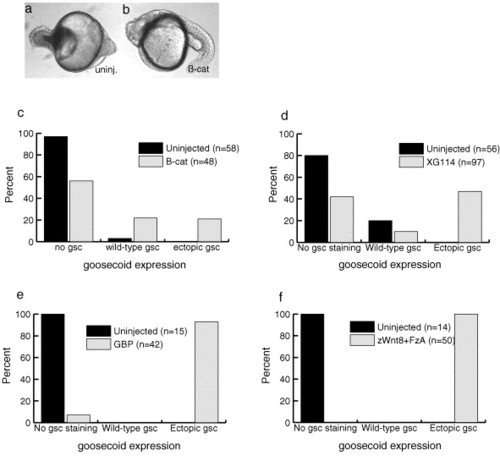Fig. 6
- ID
- ZDB-FIG-070920-43
- Publication
- Lyman Gingerich et al., 2005 - hecate, a zebrafish maternal effect gene, affects dorsal organizer induction and intracellular calcium transient frequency
- Other Figures
- All Figure Page
- Back to All Figure Page
|
Dorsal gene expression increases in hec mutant embryos upon injection of upstream components of the Wnt/β-catenin pathway. (a?b) Injection of β-catenin mRNA leads to the appearance of dorsal structures in hec mutant embryos (24 hpf; anterior to left). (c?f) The frequency of embryos expressing goosecoid increases after injection with β-catenin RNA (c), dominant negative GSK-3 RNA (XG114) (d), GSK-3 binding protein RNA (e), and zWnt8 + FzA RNAs (f). ?Wild-type gsc? refers to the presence of staining in a pattern similar to that seen in similarly staged uninjected wild-type embryos. ?Ectopic gsc? refers to the presence of staining in regions in the margin outside the normal wild-type pattern. Presence of staining in a portion of the uninjected hec mutant embryos is due to the differences in expressivity of the phenotype. Injection of β-galactosidase mRNA does not lead to an increase in dorsal gene expression (data not shown). |
Reprinted from Developmental Biology, 286(2), Lyman Gingerich, J., Westfall, T.A., Slusarski, D.C., and Pelegri, F., hecate, a zebrafish maternal effect gene, affects dorsal organizer induction and intracellular calcium transient frequency, 427-439, Copyright (2005) with permission from Elsevier. Full text @ Dev. Biol.

